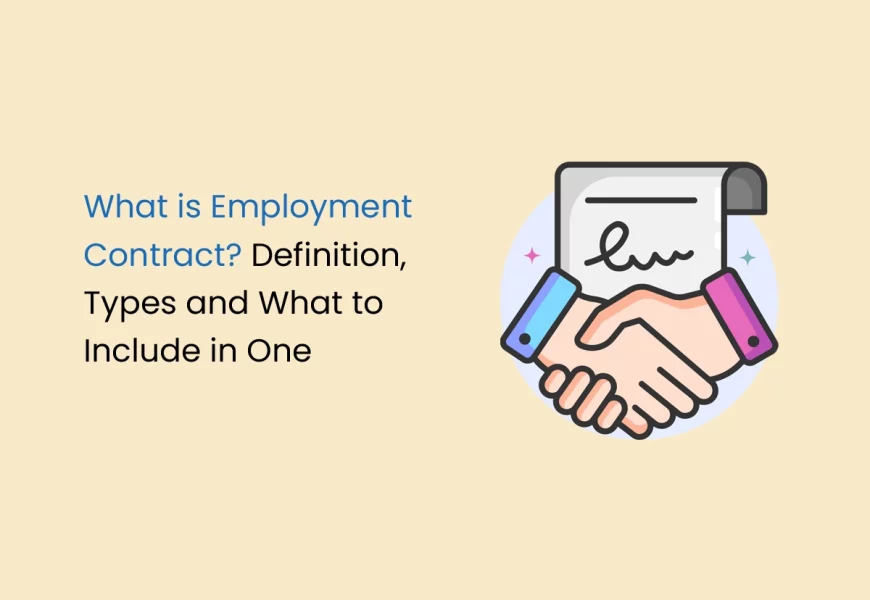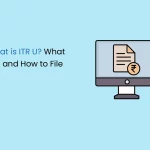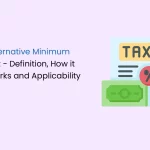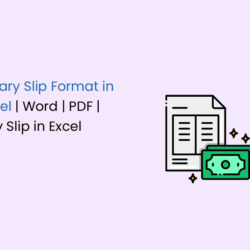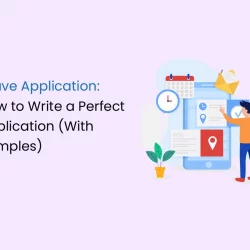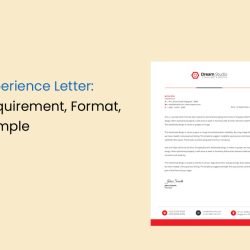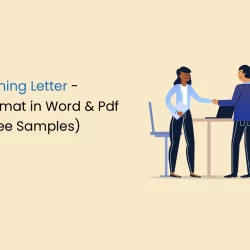An employment contract is a legally enforceable agreement that defines the terms and conditions of the relationship between an employer and an employee. It summarises the rights and responsibilities of both parties and sets expectations for their conduct in the workplace. This document serves as a vital tool to establish a clear and mutually beneficial association that protects the interests of both the employer and the employee.
This blog will detail employment contracts, their types and what is usually included in one.
What is an Employment Contract?
An employment contract is a legally binding agreement that sets out the terms and conditions of employment between an employer or labour union and an employee. Its purpose is to establish what to expect from both parties, which helps to prevent employment-related disputes. If such conflicts arise, the contract serves as a reference to interpret responsibilities and hold everyone accountable for their actions.
An employment contract is typically preceded by an offer letter. This document outlines the job details, including job responsibilities, Compensation, terms and conditions, benefits and other important information. However, an offer letter and an employment contract do not have the same legal weight.
Employment Agreement vs. Employment Contract
‘Employment agreement’ and ‘Employment contract’ are often used interchangeably but have a key factor that differentiates the two.
An employment agreement is a non-effectual arrangement between two or more parties concerning certain rights and obligations. This means that if one party fails to fulfil their obligations, the other party has no legal recourse to seek resolution or compensation.
On the other hand, an employment contract is a legally enforceable agreement between two or more parties that outlines specific terms and conditions that must be adhered to. If one party fails to fulfil their obligations under the contract, they can be held legally and financially responsible for remedying the situation.
Types of Employment Contracts
Employment contracts have the following types:
Written Employment Contract
Written employment contracts legally bind the employer and employee to agreed-upon terms, providing clarity, evidence, and a framework for the employment relationship. Signing the contract signifies mutual agreement, preventing conflicts. The contract is a valuable reference for dispute resolution.
Since both parties signed the contract, it can help prevent disputes by ensuring that all terms and conditions are agreed upon. In case of any disagreement over the terms of an employment relationship, the parties involved or a neutral third party can refer to the written contract to navigate a resolution.
Oral Employment Contract
An oral employment contract is agreed upon verbally during a discussion and is not written down. For instance, a hiring manager may make a job offer to a candidate by stating specific details such as salary, benefits and other pertinent information. If the candidate agrees to the terms, this can be considered an oral employment contract. The agreement can be further authenticated if a third party witnesses the discussion and can testify that an agreement was made. An oral agreement is just as legally binding as a written one. However, it can be challenging to prove and uphold as it relies on one person’s word against another.
Implied Employment Contract
Implied employment contracts are agreements that are not explicitly written or spoken. Instead, they are inferred from an employer’s statements, actions, or previous conduct. When employees assume they will receive the same rights, protections, and benefits the employer has previously stated, documented, or granted, obligations can arise.
Implied contracts can arise when employees assume they will receive the same rights, protections, and benefits the employer previously granted. An employee handbook or job security through good performance or long-term employment can establish an implied contract. If there are policies, actions or documentation to refer to, it can be proven that such a contract exists and is legally binding.
Temporary Employment Contract
Temporary employment contracts are commonly used for short-term employment relationships that have established start and end dates. This type of contract provides a flexible staffing option, allowing employers to fill in for a person on leave, assist with a project, handle seasonal work, or offer a trial period before hiring someone as a regular employee. These contracts can be made directly between an employer and an individual or between an employer and a staffing company that handles the worker’s payment.
At-Will Employment Contract
At-will employment is where both the employer and the employee engage by choice and can leave at any time. The contract for at-will employment may include stipulations similar to those for regular employment. Still, it does not specify any guaranteed rights or length of employment.
Under the at-will contract, employees can quit their jobs at any time. Similarly, employers can terminate their employees anytime for any reason, as long as it is not discriminatory or violates labour laws. However, the employer must still enforce the contract terms despite the employee’s at-will status.
Fixed-Term Employment Contract
A fixed-term employment contract is an agreement where an employee works for a specific period or until a particular assignment is completed. Such contracts usually offer the same benefits and protection that regular employees receive.
After expiration, fixed-term contracts can be extended, renewed, or terminated. Sometimes, it can even lead to a more permanent employment agreement. However, there may be limitations on how many times they can be renewed. Generally, they cannot be terminated early unless there is a valid reason.
Union Contract
Union contracts apply to workers who are part of a trade vocation that came together to promote their shared interests. Union members may work for the union itself or a private/governmental organisation, and a contract always secures their employment.
The terms of union contracts are determined through a process known as collective bargaining. The workers initiate the terms, which the union leaders then negotiate. Members subsequently vote to either accept or reject the contract. Once it is in place, both parties are obligated to follow the terms, except in exceptional circumstances.
What to Include in an Employment Contract
A standard employment contract includes the following:
Job Information
When drafting employment contracts, it’s crucial to provide a comprehensive description of the position, including the job title and a detailed list of general duties, responsibilities, and performance expectations the employee must fulfil. Specify the team or department assignment where the employee will work, the work schedule, or the required hours. By including this information in the employment contract, the employer and the employee can clearly understand the job requirements and expectations, which can help ensure a smooth and productive working relationship.
Technical Details
When drafting an employment contract, it’s crucial to include certain details to ensure clarity and mutual understanding between the employer and employee. This includes specifying the contract’s effective date and termination date and clearly stating the type of contract being offered, such as temporary, at-will, or fixed-term.
Additionally, the contract should outline the process for resolving disputes through arbitration, mediation, or the courts and specify which legal entities can interpret the contract and resolve disagreements. This will provide both parties a clear understanding of their rights and obligations and help prevent future disputes and misunderstandings.
Compensation and Benefits
In an employment relationship, compensation is a critical factor that shapes the employer-employee dynamic. Therefore, meticulous attention to detail regarding wages and benefits within the employment contract is paramount. The description of compensation and benefits should include:
- Employee Classification: Specify whether the employee is classified as exempt or non-exempt, clarifying their eligibility for overtime pay and other regulatory considerations.
- Salary or Hourly Wages: Clearly outline the employee’s compensation structure, including the base salary or hourly wages they will receive, ensuring transparency and understanding from the outset.
- Payday Schedule: Detail the frequency and schedule of paydays, providing predictability and clarity regarding when the employee can expect to receive their compensation.
- Bonuses, Commissions, and Incentives: Provide comprehensive information about performance-based bonuses, signing bonuses, commissions, or incentive programs available to employees, fostering motivation and engagement.
- Health and Insurance Benefits: Thoroughly describe the health and insurance benefits offered, including details about the type of insurance plan, coverage limits, premiums, and any additional perks or options available.
- Stock Options or Profit-Sharing Plans: If applicable, articulate the employee’s eligibility for participation in stock options or profit-sharing plans, highlighting the potential for long-term financial growth and alignment with the company’s success.
- Investment and Retirement Plans: Furnish details about participation in investment or retirement plans, empowering employees to make informed decisions about their financial future and retirement readiness.
Policies on Vacation, Sick days or Time off
When drafting an employment contract, it’s crucial to make sure that the organisation’s time off policies are clearly explained. This includes all types of leaves, such as vacation, sick leave, holidays, family and disability leave, and any other available types. The contract should also clearly state how these leaves are accrued or become available to the employees. Additionally, the contract should outline any unpaid leave situations and how they will be handled. Employees will clearly understand their time off benefits and the organisation’s policies by providing this level of detail in the employment contract.
Agreements
An employment contract usually ensures that employees agree to specific limitations that protect the organisation’s business interests. This is achieved through the following contract clauses:
- Non-Disclosure: This clause relates to privacy expectations and forbids employees from disclosing confidential or proprietary information to competitors during or after their employment with the company.
- Non-Compete: This clause concerns future competition and restricts employees from working at a competitor firm or starting a competing business within a specified period after their employment ends. There may also be a non-solicitation clause to prevent employees from soliciting the employer’s customers or other employees.
- Ownership/Intellectual Property: This clause concerns control over work-related enterprises. It clarifies that any materials, designs, or communications the employee produces while performing their duties are the employer’s property and under its control.
Employment Period
An employment contract must specify the duration of employment. The duration may be a specific time frame set by specific dates or may depend on the length of a project. Sometimes, employment may be classified as ongoing without any specific end date. However, it’s crucial to note that even ongoing employment may be subject to termination by either party, as specified in the contract. Additionally, it’s worth noting that some contracts may set a minimum duration for employment, with the option of an extension or renewal upon mutual agreement.
Termination
An employee contract typically includes terms for how much notice an employee must give if they want to leave their job early. It can also outline specific actions by the employee that would be considered grounds for contract termination.
In addition, the contract may dictate certain requirements for both parties upon termination, such as severance packages or returning company property or equipment. Garden leave policies may also apply if the employee holds a high-profile role.
How to Write an Employment Contract
The following steps can help in writing an employment contract:
- Give the Contract a Title: Every employment contract should have a clear title that describes its purpose. The title should be brief and self-explanatory so the person reviewing or signing it knows what it is. Some examples of titles could be ‘Employment Agreement’ or ‘[Compan name’s] Employment Contract’. A clear title can help avoid confusion and ensure everyone is on the same page.
- Determine the Parties: The parties involved in the agreement should be identified. For instance, ‘This employment agreement is between [Company Name] (the Employer) and Mr. XXXX (the Employee)’. Clear identification of the parties avoids confusion and establishes the roles of each party.
- Create a List of Terms and Conditions: An employment contract should specify the terms and conditions of the agreement between the employer and the employee. It’s important to review your state and local employment regulations to ensure that you comply with the minimum requirements. Other terms, such as benefits, sick pay, dress code, and other words, are frequently mentioned. You can also include details about probationary periods, termination, resignation, and other relevant information. The contract should clearly define the employee’s role and responsibilities and the employer’s expectations.
- Describe the Duties and Responsibilities of the Position: It’s essential to provide a clear and detailed description of the new hire’s job responsibilities. This will help them understand what is expected of them and ensure they can perform their job to the best of their abilities. Provide a detailed description of the job responsibilities, possibly with percentages for each task, to help the employee understand expectations thoroughly.
- Include Information on Compensation: The employment contract should specify the terms of the employee’s salary, annual bonuses, overtime pay, and which vacations are paid and unpaid. It should also include details about other benefits, such as health insurance, retirement plans, etc.
- Use Specific Contractual Language: The employment contract should use specific contractual language that is distinctly defined and understood by both parties. This includes the agreement’s effective date, the nature of the employment, notice periods, employee termination, dispute process, applicable legislation, and severability. Be sure to use clear and concise language that is easy to understand.
- Seek Legal Advice from an Employment Attorney: Consult with an employment attorney to review the drafted employment contract to ensure compliance with relevant laws and regulations. Legal expertise helps mitigate potential disputes and ensures the contract’s enforceability. Attorneys can provide valuable insights into employment laws and regulations, enhancing the contract’s effectiveness in protecting the company’s interests.
Employment Contract Template
The following is an employment contract template that can be used to customise an agreement with a new employee:
Employment Contract
This employment contract is being created on the [Date] between the [Employer Name] located at [Company’s Address] and [Employee Name] residing at [Address]. This agreement is binding between both parties and is governed by the laws of [State/District].
Employment
The following is an agreement that will begin on [Start Date], last for one (1) year, and end on [End Date]. The employee agrees to fulfil all the duties and responsibilities associated with their position as defined by the company’s policies, rules, and procedures. This contract may be renewed or terminated based on the terms and conditions.
Position and Duties
As a [Job Title], the employee agrees to perform assigned responsibilities.
Compensation
The employee will receive an annual salary of [Amount] for the entire duration of this contract. The payment will be made in monthly instalments. Additionally, the employee will be entitled to receive the following benefits, subject to the company’s policies and eligibility:
[List of Benefits]
Probationary period
During the initial [time frame] of employment, the employee shall be considered on probation. During this period, the employee won’t be eligible for any benefits or paid time off. Additionally, the employer retains the right to terminate the employee’s employment without prior notice or severance pay.
Termination
Either party may terminate this agreement at any time by giving [Notice Period] days’ written notice or payment instead of notice, except when termination is based on a valid reason.
Confidentiality
The employee agrees to maintain all confidential information of the employer, both during and after the employment term, and will not disclose such information to any other party.
Non-competition
The employee agrees that, following the termination of this contract, they will not work for a company related to or in competition with the company.
Entire agreement
This contract constitutes the entire agreement between the employer and employee. It can be modified with written consent from both parties.
Severability
If any part of this contract is deemed invalid or unenforceable, that part will be removed from the agreement, and the rest of the contract will remain in effect. The employer and employee signed and executed this contract on the date provided.
Employee Signature ________________
Date ________________
Company’s Signature ________________
Date ________________
Advantages and Disadvantages of an Employment Contract
The advantages and disadvantages of employment contracts are as follows:
Advantages
The advantages of employment contracts are as follows:
- Clearly Defines Duties and Benefits: An employment contract outlines job responsibilities and compensation details, leaving no room for ambiguity. It ensures that both parties understand what is expected from them, fostering a transparent and informed working relationship.
- Protects Each Party: Employment contracts provide legal protection for the employer and the employee by establishing clear rights and responsibilities. It reduces the likelihood of disputes and ensures that the concerned parties are treated fairly throughout the employment relationship.
- Provides Stability: Signing a contract offers stability and security to the employee and the employer. By clearly defining terms such as compensation, working conditions, and termination procedures, the contract helps create a predictable and structured environment, promoting trust and confidence.
Disadvantages
The disadvantages of employment contracts are as follows:
- Limits Flexibility: Employment contracts can limit flexibility for employers and employees. Once signed, it binds both parties to the terms of the agreement, making it difficult to make changes or adapt to evolving circumstances without mutual agreement.
- Legally Binding: Employment contracts are legally binding documents, and intruding on the terms of the agreement can lead to legal consequences. Both parties must adhere to the contract’s terms to avoid potential penalties or legal disputes.
- Can only be changed through Renegotiation: Any changes to the original agreement require mutual consent from both parties, which can be time-consuming and challenging. This lack of flexibility may hinder adaptability in dynamic work environments or when unforeseen circumstances arise.
Who Needs an Employment Contract?
All employers, human resource managers, and recruitment officers should use an employment contract when hiring new employees or when current employees switch positions. An employment contract outlines the expectations of both parties and provides legal protection to both sides. Scenarios where the use of employment contracts becomes essential are as follows:
- Senior positions, where an employer-side attorney and employee-side attorney usually review and negotiate the contracts.
- Union-represented employees in public and private sectors, such as teachers’ and manufacturing unions.
How HR Can Support the Employment Contract Process
Inefficient processes during the employment contract phase can result in a negative perception of the organisation among employees. To avoid this, HR departments have a crucial role to play.
By following transparent and fair practices, HR can help build confidence in the employment contract process. They can also eliminate any confusion or misunderstandings by ensuring that all details are accurate and that employees are fully conscious of their rights and responsibilities.
Tips on How HR can add to the Employment Contract Process
The tips for HR to add value to employment contracts are as follows:
- Verify that the contract details match the job description and are up-to-date.
- Allow ample time for employee review before signing.
- Encourage thorough reading and provide prompt answers to questions.
- Incorporate contractual obligations into performance reviews.
- Track contract deadlines and communicate changes to employees.
- Advocate for employees and point out unfair contracts or breaches of agreements.
Conclusion
Employment contracts initiate the terms and conditions of employment. They promote transparency, fairness, and a productive workplace. Employers and employees should carefully draft and sign equitable contracts that reflect their interests and obligations.
Frequently Asked Questions
What should a contract of employment include?
An employment contract includes employer and employee information, compensation, benefits, role, responsibilities, termination, notice period, work schedule, and other requirements.
How long is an employment contract valid?
Employment contract validity depends on employer conditions. Both parties must fulfil fixed-period contracts.
Are employment contracts confidential?
Employees must keep confidential documents covered by a non-disclosure clause in their employment contract. These obligations are legally binding.
Can the employer withdraw the offer after signing the contract?
The employment contract is binding once signed. Offer withdrawal is not allowed, but it can be done before signing.
What are the employment contract Acts in India?
In India, employment contracts are regulated by various laws, such as the Indian Contract Act of 1872, the Industrial Disputes Act of 1947, and the Shops and Establishments Act. Written employment contracts are mandatory for most employees.
What is a signed employment contract?
It is a legal document summarising an individual's employment terms and conditions with a new company. Both you and your employer sign the contract to signify your agreement.
Can I break my employment contract?
Breaking an employment contract in India may result in legal consequences such as penalties or claims for compensation.

